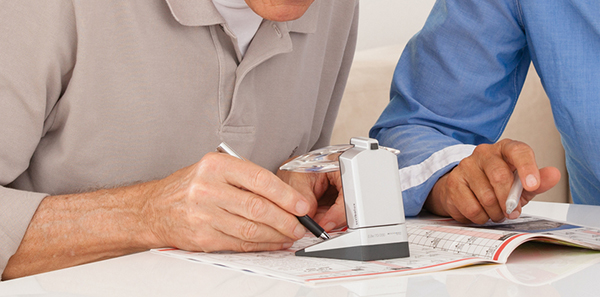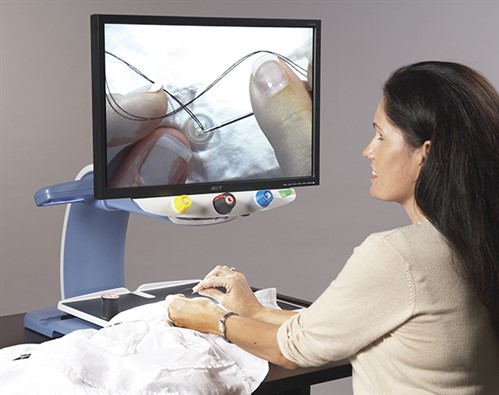1:30min

Photo: Eschenbach Optik GmbH
______________________________
By Paul Graveson
BOptom BA GradCert(Optom) PGCOT
Optometrist, Low Vision Consultant
This is the first of a six-part series of articles on low vision and part of a project I am undertaking with funding from the Tasmanian Optometry Foundation. The articles are intended for the general optometrist rather than those with a special interest in low vision.
______________________________
Let’s start with four thought-experiments.
Little specks on a small white pearl are actually a message inscribed in tiny black letters. To read the message we need some form of magnifier: perhaps a magnifying glass, a microscope or a strong plus lens from our trial set.
In an underground bunker, big black words are written on a white wall; however, the bunker has no windows and is completely dark. A magnifier is no use down here. The only answer is obviously to turn on the light.
A paper scroll is old and yellowed. Its text was originally written in large, clear letters but over the centuries the ink has faded to almost nothing. Magnifiers won’t help, because the letters are already large. Light won’t help either, as even under bright sunlight the letters are still too faint to make out; however, by photographing the scroll and carefully adjusting the contrast in the image, the words can be made readable.
Finally, consider an old map in a dim attic. The details are very small, but not as tiny as the writing on the pearl. The attic is dim, but it’s not totally dark like the bunker. The message is faded badly, but not as badly as the scroll was.
Should we reach for a magnifier, a torch or both? Should we take the map into the sunlight? Do we need to photograph the map for image enhancement?
In the first three experiments, we successfully met the challenges of making things bigger, then brighter and then bolder (providing more contrast). Each was an extreme situation in which there was only one possible answer.
That last challenge is more realistic and encompasses the essence of low vision work. There are several possible solutions to the problem of reading the map, and that’s usually how things are for the tasks our patients are struggling with. Just like altering contact lens parameters, or bringing IOP down in glaucoma, or helping a child with convergence insufficiency, there may be more than one way to achieve the result we need.

Photo: Freedom Scientific
Understanding
Being an effective low vision optometrist involves understanding not just the different ways you can help, but also why one method might be more suitable for one patient but a different method might be better for someone else.
We are all ‘low vision’ optometrists. We all deal with patients coming in for help with things they cannot see with their regular spectacles. Maybe they need a task-specific pair of glasses with a stronger add, or a special magnifier, or simply to sit near a sunny window; or maybe they need something more elaborate. Once you understand how the underlying visual dysfunction works, it’s just a matter of working with the patient to find the best solution for them.
Problem-solving in low vision requires a knowledge of the products available, an understanding of visual dysfunction, and the communication skills to understand which tasks a patient really needs help with and judge which low vision aids they will be able to learn to use. All that and a fair dash of creative thinking.
There are many professions involved in low vision care in Australia and they all bring something special to the table. The understanding of visual dysfunction and magnification is where optometrists really shine. No other profession understands visual function and optics so well. That makes us valuable, either on our own or ideally as part of a multidisciplinary team.
In writing these articles, my goal is to help you understand not just which solutions are available but also why we might choose one over another for particular situations.
In the next article, I’ll discuss the ways we can use illumination for patients with low vision. After that, I’ll concentrate on magnification and then contrast. Then I’ll round off with two articles discussing the pros and cons of the various types of low vision aids.
READ
LOW VISION: Part 2. Illumination
LOW VISION: Part 3. Magnification
LOW VISION: Part 5. Choosing aids
LOW VISION: Part 6. More about aids
______________________________
This series of articles has been prepared with the support of the Tasmanian Optometric Foundation. Contact Paul Graveson at admin@hobartoptometry.com.au.